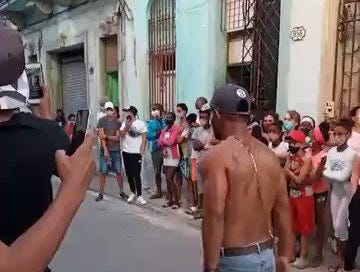Cuba: Protestas, Patria y Vida
A new round of protests in Cuba fits quite well into the recent LatAm protest wave
On one hand, something about the current round of protests against the Cuban government feels significant and worth writing about.
On the other hand, how many times have analysts pointed at the unique factors of new protest movements in Cuba only to see them get crushed, repressed or co-opted in the usual way?
There isn’t just one protest movement or leader at the moment. Instead, several groups of protesters are operating independently and with different strategies.
The San Isidro Movement is a group of artists who have spent the last two and a half years criticizing Cuban government requirements to have their art pre-screened and approved. They managed to maintain momentum and even appeared close to obtaining some concessions from the Cuban government last year. Their Twitter feed has spent recent hours documenting the detained and disappeared by security forces.
The Patria y Vida music video (see this BBC video for a good explanation in English as well as the government’s counter-propaganda) has played off the San Isidro Movement but also added to it.
The protest feedback loop created by the MSI and the video has brought a younger and more disruptive group of protesters to the streets in recent days. These are protesters who are willing to provoke the government rudely and taunt the security forces in an effort to escalate the tensions, as the video posted to social media below demonstrates. This activity, defined by protester rage, is moving closer to the strategies employed by South American protest groups in recent years (for example, how Chilean protesters treat police) and a contrast to many of Cuba’s prominent protest movements in the past few decades who often maintained a relatively polite and formal respect for a non-violent civil disobedience strategy.


Along the more traditional lines, a hunger strike is ongoing in Santiago de Cuba to protest government abuse. José Daniel Ferrer leads the Patriotic Union of Cuba (UNPACU), one of the better organized political opposition groups in the country. Ferrer was using the UNPACU offices in Santiago to coordinate and distribute aid during the recent economic downturn. The government has harassed the group and any citizens who have attempted to receive their aid. One thing the ruling regime fears most is the ability for local groups to organize and provide help to people without working with the government. After all, if people can help themselves, then the government loses a critical lever of control.
One theme to watch in these protest movements is the transition back and forth between protests about political rights and criticisms about the mismanagement of the economy and lack of basic necessities. That second category appeals to a larger number of Cuba’s citizens and the Diaz-Canel government sees those criticisms as a more significant threat.
Those aren’t the only protesters. Many groups that have protested for years remain including the Ladies in White (Damas de Blanco). The success of eventual protests may hinge on how the various protest groups interact and coordinate. The Diaz-Canel government will almost certainly attempt to expose fissures among the groups while simultaneously attempting to pin the worst or most violent activities of any one group on all of the government’s opponents.
Cuba’s protest movement is a big Latin American protest waiting for a spark
Cuba is often treated as its own special case, but the current movement is quite similar to other recent waves of Latin American protests. There is a basic structure to protests here that is far from unique to Cuba.
People are upset at the failures of the national government to provide the basic necessities and services and citizens feel they deserve.
The economic recession caused by the pandemic (exacerbated in Cuba by the drop in tourism and effects of US sanctions) has further angered the population.
Repression by abusive security forces has helped escalate the protests and drive additional protesters to the street who did not join the first movement.
One important difference is that there has been no specific catalyst or spark to the current wave of protests. Instead, these protests have slowly built across months and even years. I could point to five or six small events since 2018 that might be considered a “spark” (two being the Culture Ministry decree in 2018 and the arrest of Denis Solís), but none of them feel like the big moment that everyone will say, “that was the moment the protests began.”
Keep that in mind moving forward. Cuba’s population is primed for a big spark to escalate the protests from their current levels. I say that with caveats. I don’t know if a spark will occur. I do not want to underestimate the government’s ability to smother the protests if they really began to surge. But having watched other protest movements in recent years in Latin America, what stands out to me right now about Cuba’s situation is how it could potentially escalate much further than it already has.
Many people outside Cuba look at protests only through the lens of whether the protests will topple the regime. That seems highly unlikely. However, a large protest movement involving a larger portion of the population could obtain concessions from Diaz-Canel and create conditions for more liberalization years down the line. If that is where this current movement leads, it would be a success.
Thanks for reading
Have a good afternoon.


